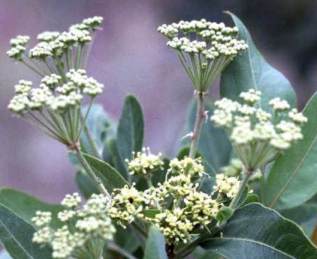Heteromorpha arborescens
Heteromorpha arborescens (Spreng.) Cham. & Schltdl.
Family: Apiaceae
Common names: parsley tree (Eng.); wildepietersielie, pietersieliebos (Afr.), umbangadlala (Zul.), umbangadlala, umbangandlatho, umbangeza, iyeza-lempambano (Xho.)
SA Tree No: 568
Introduction
This small to medium-sized, deciduous tree or straggly shrub is suitable for a small, low-maintenance garden. The bark often helps to distinguish it from other species, for it is papery and smooth, peeling off horizontally and leaving ring-like scars below. When new, these have a surface like the finest satin.

Description
Description
There are four varieties (var. abyssinica, var. arborescens, var. collina, var. frutescens) of this variable, widely distributed tree. Heteromorpha arborescens var. abyssinica = Heteromorpha trifoliata. The parsley tree has several distinctive features. The bark is smooth and shiny and peels off in horizontal flakes.

The leaves are variable in size and shape and may be simple to variously compound. They are light green to grey-green and may turn yellow and red before falling in autumn. When crushed they smell of parsley or parsnips, hence the common name.
The small green or yellow flowers are strong-smelling, inconspicuous and arranged in umbels, i.e. all the stalks arise from the same point. Flowering times are December-January.
The small, winged fruits have two wings on the one side and three wings on the other side and they are creamy brown and form from April onwards.

Distribution and habitat
Distribution description
It occurs in wooded grassland, bushveld and on forest margins. It is fairly widespread in the eastern regions of South Africa, from the southern Cape up through Eastern Cape and eastern Free State, Kwazulu-Natal, Swaziland into Gauteng, Mpumalanga and Limpopo. It also occurs further north in Africa.
Derivation of name and historical aspects
History
Heteromorpha refers to the Greek word meaning different forms, for it assumes a different guise from area to area over a large part of the African continent, and arborescens refers to its tree-like habit. Apiaceae is a family with about 257 genera and over 2 250 species spread throughout the temperate regions of the world. In South Africa it is represented by about 30 genera. This family has played a considerable role in the lives of humans because many species have food and medicinal value. Parsley, celery, carrots ,caraway and aniseed, just to mention a few, belong to it.
Ecology
Ecology
There are few species of trees that bear sometimes simple and sometimes compound leaves, and this is one of them (Palmer & Pitman 1973). In the Cape many wild parsley trees have simple leaves, whereas those to the north tend to have pinnate leaves with three, five or seven leaflets. The leaves are also very variable in size and shape.
Uses
Use
The main use of the plant is to treat abdominal pains and intestinal worms in children with an infusion of leaves used as an enema (Palmer& Pitman 1973). It is also used to treat nervous and mental disorders. A decoction of the root is used to treat shortness of breath, coughs and dysentery. Smoke from the burning plant is inhaled to treat headaches. The tree is planted with charm intent in everylekhotla (meeting) in Free State, Lesotho. It is also planted in the kraals of chiefs in Lesotho to ensure the loyalty of the people.
The timber is very soft and decays so rapidly that it is poor fuel. The Xhosas make musical bows of it (Pooley 1993). In the Okavango territory, Africans use the roots as an aphrodisiac.
Growing Heteromorpha arborescens
Grow
Heteromorpha arborescens grows easily from seed sown in early summer (October till December). The seed needs to be thinned out and sown in a plug tray in a sowing medium of one part compost to one part river sand. Keep the plug tray in a shady area. Wate revery second day: do not allow the sowing medium to dry out. The seed starts to germinate after about two weeks. After three months the seedlings can be transplanted in a medium of red clay soil (8spades), coarse river sand (4 spades) and one bag compost (30 cubicdecimetres). Mix well (Chris Mynhardt pers. comm.).
Another method of propagation is by means of cuttings even though these may be lying around on the ground for a month or so before being planted (Carr 1994). From what I have seen in the garden many of the seedlings grow under other trees. Once established, the plants are frost and drought resistant, making them ideal for an inland garden.
References
- Carr, J.D. 1994. The propagation and cultivation of indigenous trees and shrubs on the Highveld, Natal. Sandton Nature Conservation Society and the Tree Society of Southern Africa.
- Coates Palgrave, M. 2002. Keith Coates Palgrave Trees of southern Africa, edn 3. Struik, Cape Town.
- Palmer, E. & Pitman, N. 1973. Trees of southern Africa. Balkema, Cape Town.
- Pooley, E. 1993. The complete field guide to trees of Natal, Zululand and Transkei. Natal Flora Publications Trust.
- Van Wyk, B-E., Van Oudtshoorn, B. & Gericke, N. 1997. Medicinal plants of South Africa. Briza Publications, Pretoria.
- Van Wyk, Braam & Van Wyk, Piet. 1997. Field guide to trees of southern Africa. Struik, Cape Town.
Credits
Shireen Harris
Free State National Botanical Garden
October 2003
Plant Attributes:
Plant Type: Tree
SA Distribution: Eastern Cape, Free State, Gauteng, KwaZulu-Natal, Limpopo, Mpumalanga, North West, Northern Cape, Western Cape
Soil type: Sandy, Clay, Loam
Flowering season: Early Summer, Late Summer
PH: Acid, Alkaline, Neutral
Flower colour: Green, White, Cream
Aspect: Full Sun, Morning Sun (Semi Shade), Afternoon Sun (Semi Shade)
Gardening skill: Easy
Special Features:
Horticultural zones











Rate this article
Article well written and informative
Rate this plant
Is this an interesting plant?
Login to add your Comment
Back to topNot registered yet? Click here to register.